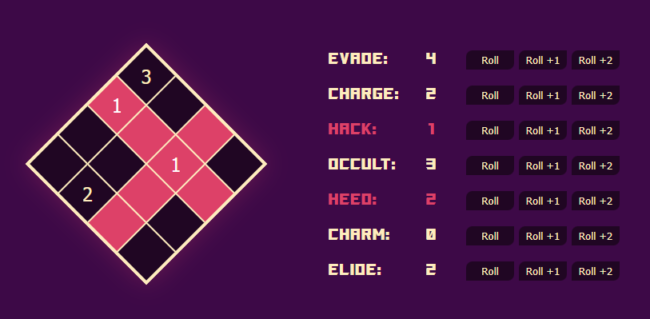Caro Asercion, 1-5+ players, 2-3 hours, $7.77
⚫⚫⚫⚫⚪ — Ease of Play
⚫⚫⚫⚪⚪ – Replayability
⚫⚫⚫⚫⚪ – Fun
Dwindle is a self-contained indie RPG designed to let you run an “occult cyberpunk” scenario in the dying tech metropolis of Vector City.

VECTOR CITY used to gleam, its wireframe skylines shimmering against a perpetual pixel sunset. But the Vector’s heyday is long gone, and you — the ECHOES of this former metroscape — are left tending to the wreckage.
You’re no more special than any of the other stragglers stubborn enough to stick around; people here live hardscrabble lives full of risk and danger, and the difference between success and obliteration is as fickle as static in the wind. But without somebody to keep things running smoothly, it’s only a matter of time before the ghosts and the glitches and the corporate bastards eat away at every last bit of data and render this husk of a city entirely unrecognizable.
You won’t let it disappear without a fight.
Written by Caro Asercion, the game does a quite decent job of letting you generate characters (it can be played GMless if you like) and develop a scenario. Characters and the city are seeded (randomly, if you wish) by tables with interesting people, gadgets, goals, and problems to guide game play. There’s enough there I suspect for a number of replays before things might to seem repetitive.

Dwindle’s most unique mechanic is its use of a grid to place seven dice into. The sum of dice for each row and column give you dice to roll for different actions/attributes (with bonus dice for reputation or use of a trinket in your pocket) — the highest die rolled provides a range of success or failure for the group to interpret.

The trick is, those dice you rolled get removed from your grid, meaning, as the game name implies, your abilities and options dwindle over time, until you reach a situation where the highest die you roll (or, if you are at 0 dice available, the lower of two dice) scores a 1, at which point you can replenish the grid in whatever way you like.
It sounds a little complex, but it’s mechanically simple, esp. if you use the digital interface by Tim Busuttil. The main thing is figuring out when best to shoot big dice, realizing you’ll be seriously weakened until you can figure out how to replenish.
The Good
- Intriguing setting, neatly set up for a variety of adventures.
- Clean and pretty rule set, plus a text-only version if that’s how you roll.
- Interesting attribute / rolling grid (with digital tool).
- Great for a one-off / fill-in session.
- Can be run without a GM.
- Can be played tabletop or virtually (if you trust your players’ rolling).
The Not-As-Good
- Limited replays without brainstorming some new elements for the tables.
- Characters may feel a little generic, as dice can replenished in whatever arrangement you wish.
- Most die results are mixtures of success and failure, making it difficult to feel an unalloyed success.
- Attribute tags sometimes drive, rather than guide, the action (“I have dice left in this, so that’s what I should do”).
- In the session we played, we dwindled pretty quickly, and didn’t have a lot of luck replenishing.
It’s a fine one-night stand-in when a key player or the GM can’t make it for the regular session. I’m glad we played it, and I’d enjoy playing (or even GMing) it again.
Do you want to know more?

